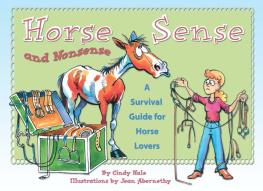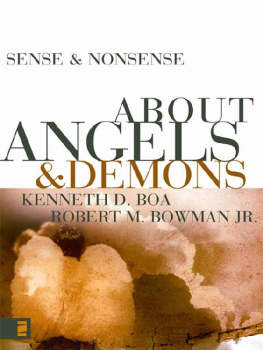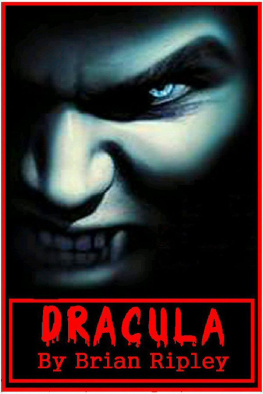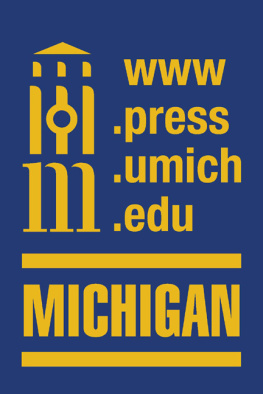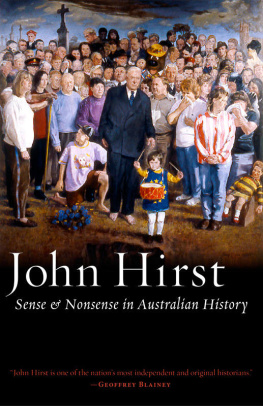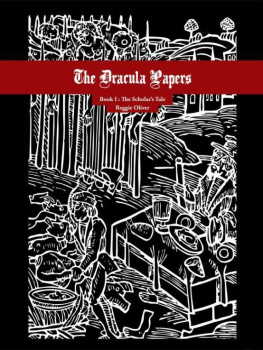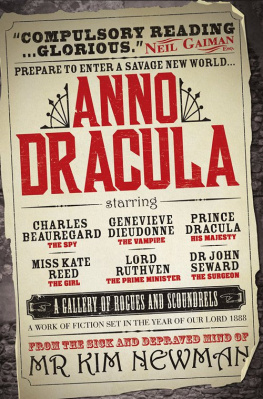Elizabeth Miller - Dracula: Sense and Nonsense
Here you can read online Elizabeth Miller - Dracula: Sense and Nonsense full text of the book (entire story) in english for free. Download pdf and epub, get meaning, cover and reviews about this ebook. year: 2012, publisher: Desert Island eBooks, genre: Detective and thriller. Description of the work, (preface) as well as reviews are available. Best literature library LitArk.com created for fans of good reading and offers a wide selection of genres:
Romance novel
Science fiction
Adventure
Detective
Science
History
Home and family
Prose
Art
Politics
Computer
Non-fiction
Religion
Business
Children
Humor
Choose a favorite category and find really read worthwhile books. Enjoy immersion in the world of imagination, feel the emotions of the characters or learn something new for yourself, make an fascinating discovery.

- Book:Dracula: Sense and Nonsense
- Author:
- Publisher:Desert Island eBooks
- Genre:
- Year:2012
- Rating:3 / 5
- Favourites:Add to favourites
- Your mark:
- 60
- 1
- 2
- 3
- 4
- 5
Dracula: Sense and Nonsense: summary, description and annotation
We offer to read an annotation, description, summary or preface (depends on what the author of the book "Dracula: Sense and Nonsense" wrote himself). If you haven't found the necessary information about the book — write in the comments, we will try to find it.
Dracula: Sense and Nonsense — read online for free the complete book (whole text) full work
Below is the text of the book, divided by pages. System saving the place of the last page read, allows you to conveniently read the book "Dracula: Sense and Nonsense" online for free, without having to search again every time where you left off. Put a bookmark, and you can go to the page where you finished reading at any time.
Font size:
Interval:
Bookmark:
by
Elizabeth Miller
Desert Island eBooks

www.desertislandbooks.com
First edition (hardback) published in 2000
Second edition (paperback) published in 2006
Ebook edition (from second edition text) published in 2011
by
DESERT ISLAND BOOKS
United Kingdom
www.desertislandbooks.com
2000, 2006, 2011 Elizabeth Miller
The right of Elizabeth Miller to be identified as author of this work has been asserted under The Copyright Designs and Patents Act 1988
British Library Cataloguing-in-Publication Data
A catalogue record for this book is available from the British Library
All rights reserved. No part of this book may be reproduced or utilised in any form or by any means, electronic or mechanical, including photocopying, recording or by any information storage and retrieval system, without prior permission in writing from the Publisher
The Desert Island Dracula Library:
Dracula: Sense & Nonsense (ISBN 978-1-905328-15-4)
Dracula Unearthed (annotated) (ISBN 978-1-905328-14-7)
Dracula: The Shade and the Shadow (ISBN 978-1-874287-10-0)
Dracula: The Novel and the Legend (3rd Ed) (978-1-874287-44-5)
The Origins of Dracula (978-1-874287-07-0)
The Primrose Path (978-1-874287-21-6)
The Shoulder of Shasta (annotated) (978-1-874287-30-8)
The Jewel of Seven Stars (annotated) (978-1-874287-08-7)
The Lady of The Shroud (annotated) (978-1-874287-22-3)
Lady Athlyne (annotated) (978-1-905328-31-4)
Snowbound (annotated) (978-1-874287-29-2)
A Glimpse of America (978-1-874287-35-3)
Mayos On the Truths of Popular Superstition (978-1-874287-69-8)
Bram Stoker: A Bibliography (978-1-874287-75-9)
Calmets Treatise on Vampires and Revenants (978-1-874287-06-3
Troublesome Corpses (978-1-905328-30-7)
There is pleasure and pain in being an aficionado of Bram Stokers Dracula, first published in 1897. The pleasure comes from the novel itself, from grappling with Stokers multi-faceted meanings and in probing its many layers of construction. I was hooked as a teenager and have been professionally engaged with Stokers magnum opus for much of my adult life. My first interpretative work Dracula: The Novel & the Legend (1985, 1993, 2001). In The Origins of Dracula (1987, 1995) I investigated the root sources of Stokers text. I have also published annotated editions of two of Stokers novels The Jewel of Seven Stars (1996) and Dracula Unearthed (1998, 2006). My wider aim, if indulgence in a pleasure requires such justification, has been to shed light on a much denigrated and misunderstood book, and its equally maligned Irish author.
The pain comes from the writings of those who, whether well-meaning or mischievous, have jumped aboard the Dracula bandwagon to pen articles or books that pay scant respect to the rules of evidence, or, to put it bluntly, are just plain daft. One might think there is little scope for such works. But this is to underestimate the power that Dracula exerts over todays book or newspaper editor. Dracula sells. End of story. Nor is an editor likely to be over-scrupulous about the plausibility or otherwise of the argument under consideration. Nothing is too outlandish for even the most respected of broadsheet editors, who appear happy to devote acres of print to the discovery of real vampires in Highgate Cemetery, or that a descendent of Vlad the Impaler has been found alive and well, operating a blood bank in Brooklyn. In short, Dracula has fallen victim to its very success.
If we take a straw poll among those casually interested in Dracula it is a fair bet that much of what they hold true is false. They will say that Count Dracula was based on Vlad the Impaler. He wasnt. They will maintain that Stoker had a real castle in mind and that it has been found. Wrong on both counts. Stoker did much of his research in Transylvania. No he didnt. The Count is harmed by sunlight. No he isnt. The short story Draculas Guest was the deleted first chapter of the novel. Impossible. The place of Lucys burial and staking was Highgate Cem etery. Highly improbable. The Hungarian scholar Arminius Vambery furnished Stoker with much information about Vlad Dracula and vampires in general. Not a chance. The list goes on and on. Elizabeth Miller contends, with many years as professor of English literature to call upon, that no comparable novel is so surrounded by a mishmash of half-truths and hocus-pocus. The search for the origins of this misinformation and the task of setting the record straight form the core of this book.
By definition, therefore, most persons named in these pages would rather not be. Nor is her axe aimed only at writers catering for popular tastes. It is those writing for an informed audience who bear the brunt of her criticism, for they must assume the greater responsibility for having shaped learned opinion. Few are spared: not Elizabeth Miller herself, as she catches errors in her own earlier work; and certainly not me, whom she hauls over the coals rightly so too often for comfort.
That Vlad the Impaler was Stokers inspiration for Count Dracula is by far the most egregious misconception surrounding the novel. How did this lamentable confusion arise? The course of events is pretty clear. As recently as 1970 the serious literature on Dracula amounted to little more than a handful of articles and a full-length biography of Stoker by Harry Ludlam (1962). For those curious to learn more, there was nowhere else to turn. At this point, up stepped two Boston history professors, Radu Florescu and Raymond McNally. Theirs was every scholars dream come true. They had found a tabula rasa, a field barren of competing expertise on which they could impose their imprint. Their first book, In Search of Dracula (1972), was a publishing sensation, becoming the first non-fiction work on Dracula ever to reach the best-seller lists. Clearly, they had caught the public mood, which was ripe for ever more details of the fictional count and the real-life Vlad. They soon became the worlds unchallenged authorities on both the historical Dracula and Stokers novel. The gaps they could not fill, others could. Dracula-mania swept the world.
Fair enough. But along the way Florescu and McNally enjoyed a huge slice of luck, the consequences of which provoke much controversy. Having traveled to the Rosenbach Museum & Library in Philadelphia in search of material on Vlad the Impaler, they were invited to inspect Stokers Working Notes and Papers for Dracula. If the professors looked astonished, they had every reason to. No one knew of the existence of these Notes, not even the Rosenbach, in the strictest sense, since they remained uncatalogued several years after they had been acquired and had not yet been added to the directory of the Museums holdings.
It is impossible to exaggerate the importance of these Notes, for while questions remain, and new ones present themselves, most of the speculation concerning the origins, sources, and crafting of the novel have been categorically answered. Indeed, few other nineteenth-century novels have benefited from such a comprehensive record of their composition in their authors own hand. In fact, far from being shrouded in mystery, the origins of Dracula are extraordinarily complete.
Stokers Notes remain unpublished. They are therefore accessible only to those able and willing to visit Philadelphia. Not surprisingly, perhaps, few of those who write about Dracula have gone to the trouble to examine them. Moreover, it is easy to distinguish those who have from those who have not. The evidence is apparent from what they write. For example, only those ignorant of the Notes continue the controversy over the year in which Dracula is set. In fact, no controversy exists at all; the answer is 1893. Stoker tells us himself in his Notes.
Font size:
Interval:
Bookmark:
Similar books «Dracula: Sense and Nonsense»
Look at similar books to Dracula: Sense and Nonsense. We have selected literature similar in name and meaning in the hope of providing readers with more options to find new, interesting, not yet read works.
Discussion, reviews of the book Dracula: Sense and Nonsense and just readers' own opinions. Leave your comments, write what you think about the work, its meaning or the main characters. Specify what exactly you liked and what you didn't like, and why you think so.


